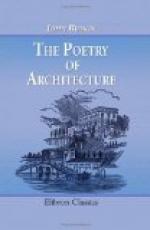36. Such, we think, are the principal distinctive attributes of the Italian cottage. Let it not be thought that we are wasting time in the contemplation of its beauties; even though they are of a kind which the architect can never imitate, because he has no command over time, and no choice of situation; and which he ought not to imitate, if he could, because they are only locally desirable or admirable. Our object, let it always be remembered, is not the attainment of architectural data, but the formation of taste.
Oct. 12, 1837
III.
THE MOUNTAIN COTTAGE—SWITZERLAND.
37. In the three instances of the lowland cottage which have been already considered, are included the chief peculiarities of style which are interesting or important. I have not, it is true, spoken of the carved oaken gable and shadowy roof of the Norman village; of the black crossed rafters and fantastic proportions which delight the eyes of the German; nor of the Moorish arches and confused galleries which mingle so magnificently with the inimitable fretwork of the gray temples of the Spaniard. But these are not peculiarities solely belonging to the cottage: they are found in buildings of a higher order, and seldom, unless where they are combined with other features. They are therefore rather to be considered, in future, as elements of street effect, than, now, as the peculiarities of independent buildings. My remarks on the Italian cottage might, indeed, be applied, were it not for the constant presence of Moorish feeling, to that of Spain. The architecture of the two nations is intimately connected: modified, in Italy, by the taste of the Roman; and, in Spain, by the fanciful creations of the Moor. When I am considering the fortress and the palace,[4] I shall be compelled to devote a very large share of my attention to Spain; but for characteristic examples of the cottage, I turn rather to Switzerland and England. Preparatory, therefore, to a few general remarks on modern ornamental cottages, it will be instructive to observe the peculiarities of two varieties of the mountain cottage, diametrically opposite to each other in most of their features; one always beautiful, and the other frequently so.
[Footnote 4: That part, however, was not written, as the “Architectural Magazine” stopped running soon after the conclusion of Part II. “The Villa.”]
38. First, for Helvetia. Well do I remember the thrilling and exquisite moment when first, first in my life (which had not been over long), I encountered, in a calm and shadowy dingle, darkened with the thick spreading of tall pines, and voiceful with the singing of a rock-encumbered stream, and passing up towards the flank of a smooth green mountain, whose swarded summit shone in the summer snow like an emerald set in silver; when, I say, I first encountered in this calm defile of the Jura, the unobtrusive, yet beautiful, front of the Swiss cottage. I thought it the loveliest piece of architecture I had ever had the felicity of contemplating; yet it was nothing in itself, nothing but a few mossy fir trunks, loosely nailed together, with one or two gray stones on the roof: but its power was the power of association; its beauty, that of fitness and humility.




